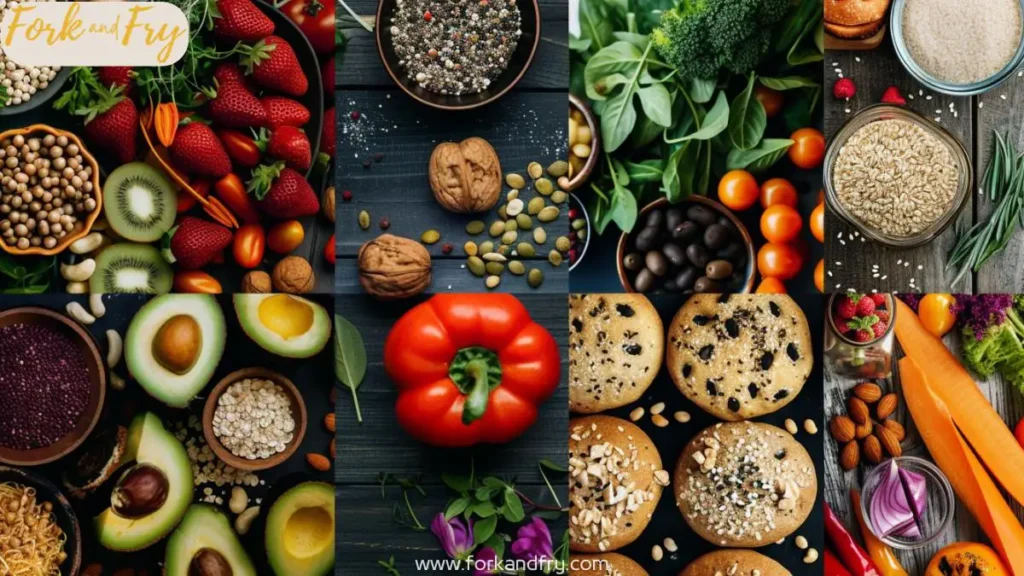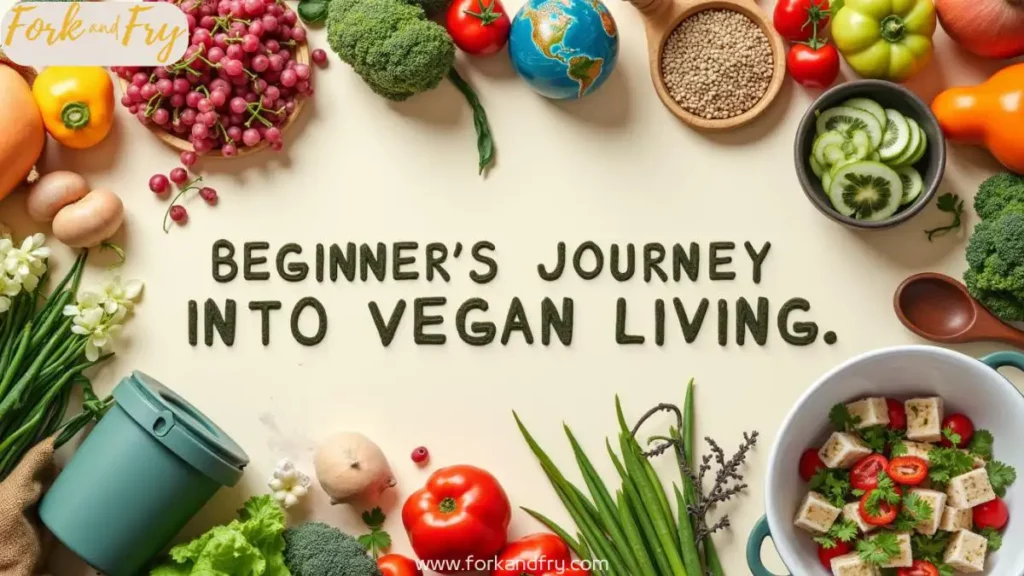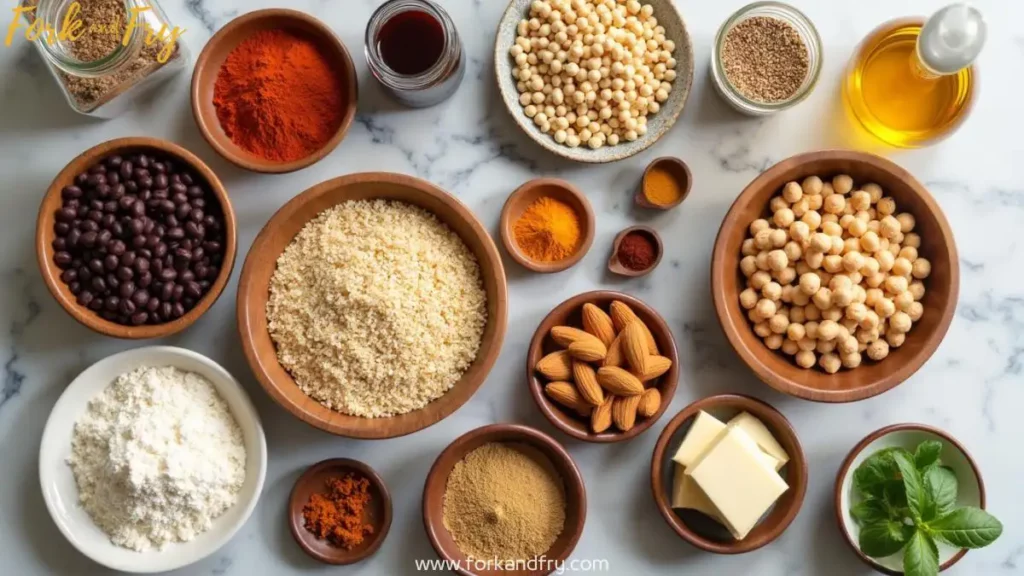Last updated on March 21st, 2025 at 03:30 pm
Table of Contents
Gluten Free Vegan Guide it´s a guide, that everyone should read! – I’m passionate about plant-based living and know how hard it can be. It’s tough to follow dietary rules while staying healthy and kind to the planet. This guide will help you start a gluten-free vegan lifestyle with ease and happiness.
Find out how a plant-based diet can make you feel great. Learn about tasty, safe recipes that are both vegan and gluten-free. Let’s explore the world of clean eating, whole foods, and cruelty-free treats together.

Key Takeaways
- Learn the basics of a vegan gluten-free lifestyle and its benefits.
- Figure out how to read food labels and ingredients to make smart choices.
- Find out how to plan meals and stock your pantry for a smooth transition.
- Try out delicious gluten-free vegan recipes for any time of day.
- Get tips on saving money to enjoy a plant-based, gluten-free diet without breaking the bank.
Understanding Gluten-Free Veganism
The vegan lifestyle means no animal products, and the gluten-free diet means no grains with gluten. Together, they form a vegan gluten-free lifestyle. This diet is 100% plant-based and avoids grains like wheat, rye, and barley.
What is a Vegan Gluten-Free Lifestyle?
This lifestyle focuses on whole, unprocessed plant foods without gluten. You’ll eat lots of fresh fruits, veggies, legumes, nuts, seeds, and gluten-free grains like quinoa and rice. It also means no animal products or gluten.
Benefits of a Plant-Based Gluten-Free Diet
This diet can improve digestion and reduce inflammation. It may also help manage autoimmune conditions like celiac disease. By planning thoughtfully, you can ensure you get all the necessary nutrients.
About 1% of people worldwide have celiac disease, needing a gluten-free diet. Veganism has grown by 600% in the U.S. in three years. Also, 3 in 10 Americans are trying to eat more plant-based foods. The gluten-free market is expected to hit $7.59 billion by 2027, with many buying these products for health reasons.
“Gluten-free vegan diets can provide a wide range of health benefits, from improved digestion to better management of autoimmune conditions. With the right planning, you can ensure your body gets all the essential nutrients it needs.”

Navigating Food Labels and Ingredients
Finding gluten-free and vegan products can be tricky. Gluten is often hidden in many foods. It’s key to know how to read food labels for a vegan gluten-free diet.
Supermarkets and food makers now clearly label vegan products. They use logos or say “suitable for vegans.” This makes it easier to find what you need.
Look for the Sunflower Trademark, the yellow V-Label, and the Certified Vegan Logo. These are signs of vegan products. But, don’t confuse them with vegetarian labels. Vegetarian products might not be vegan because they use animal products.
Companies must list allergens clearly. They use bold text in the ingredients list. They also say “Contains egg/milk/dairy” below. Some ingredients, like cream of tartar, seem non-vegan but are actually okay for vegans.
But, not all dairy-free products are vegan. They might still have animal products. Always check the ingredients.
Be careful with hidden gluten. Some E numbers, like carmine (E120), gelatin (E441), and beeswax (E901), are not vegan. Research brands online or choose organic products if you’re unsure about ingredients like sugar.

Understanding food labels and ingredient identification helps you make better choices. This way, you can stick to your vegan gluten-free diet without worries.
Meal Planning and Preparation Tips
Living a vegan gluten-free lifestyle needs careful meal planning and prep. Begin by stocking a pantry with key vegan gluten-free items. This includes gluten-free grains, legumes, and fresh veggies. It makes cooking healthy meals quick and easy.
Essential Pantry Staples
- Gluten-free grains (quinoa, brown rice, millet)
- Lentils, chickpeas, and other legumes
- A variety of fresh fruits and vegetables
- Healthy fats (nuts, seeds, avocados)
- Plant-based protein sources (tofu, tempeh, seitan)
- Gluten-free condiments and seasonings
Time-Saving Meal Prep Strategies
To save time, try these meal prep tips:
- Batch cook staples like rice, quinoa, and roasted veggies for many meals.
- Make sauces, dips, and dressings ahead, like cashew cream and hummus.
- Make smoothie packs with frozen fruits, greens, and other ingredients for quick blends.
- Bake muffins, granola, and energy bites for quick snacks.
- Use Little Spoon meals for kids, which are fresh, balanced, and fit dietary needs.
“While meal prepping may require a bit more time initially, the convenience and consistency it provides throughout the week are well worth the effort.”
Focus on meal planning and preparation to make your vegan gluten-free life easier. This way, your family gets healthy, quick meals and snacks.

Delicious Gluten-Free Vegan Recipes
Start a tasty journey with gluten-free vegan recipes. They’ll make your day better from breakfast to dessert. Find something delicious for every meal.
Breakfast Options
Begin your day with our gluten-free vegan breakfasts. Enjoy a Vegan Chocolate Sweet Potato Milkshake or Instant Pot Pear and Date Spiced Oatmeal. For a quick snack, try our Breakfast Cookies.
Lunch and Dinner Ideas
Discover a variety of gluten-free vegan meals. Try a Vegan Curry with Tofu or 20-Minute Broccoli and Za’atar Chickpeas with Yogurt Sauce. For a big meal, have our Vegan Red Lentil Curry.
Snacks and Desserts
Find tasty gluten-free vegan snacks and desserts. Enjoy a Lemony White Bean Dip or Spicy Korean Cucumber Salad. For dessert, try Vegan Fudge or No-Bake Vegan Peanut Butter and Jelly Bars.
Our recipes feature a diverse array of flavors and cuisines. They’re perfect for anyone looking for healthy, tasty plant-based meals.
Gluten-Free Vegan on a Budget
Living gluten-free vegan doesn’t have to cost a lot. A bit of planning and smart shopping can help. You can eat well without spending too much. Here are some tips to make your gluten-free vegan life more budget-friendly.
Cost-Saving Strategies
- Shop the perimeter of the grocery store. Buy whole foods like fruits, grains, and legumes. They’re often cheaper.
- Purchase in bulk. Get staples like rice, quinoa, and beans when they’re on sale or in bulk bins.
- Choose naturally gluten-free foods. Use fruits, veggies, quinoa, and others to make your meals.
- Look for affordable, gluten-free products. Chickpea pasta is a good, cheap option.
- Check food labels carefully. Make sure products don’t have wheat, rye, barley, or triticale.
Using these tips, you can enjoy a variety of plant-based meals. You won’t have to give up gluten-free options. Check out the guide for lots of tasty, affordable gluten-free vegan recipes.
| Ingredient | Quantity | Cost |
|---|---|---|
| Onions | 10 pounds | $2.19 |
| Dried Chickpeas | 4 pounds | $3.49 |
| Broccoli | 1 head | $1.00 |
| Cauliflower | 1 head | $1.00 |
| Avocados | 4 bags (4 avocados each) | $4.00 |
| Raw Peanuts | 4 pounds | $6.99 |
| “Soy Chunks” | 1 bag | $1.99 |
| Total | – | $25.04 |
This table shows how affordable a gluten-free vegan meal plan can be. By buying in bulk and focusing on whole foods, you can eat well without spending a lot. It’s a great way to follow your gluten-free vegan lifestyle without breaking the bank.
“Following a gluten-free vegan diet doesn’t have to be expensive. With a little creativity and smart shopping, you can enjoy delicious, nutritious meals that fit your budget.”
gluten free vegan

More people are choosing a gluten-free vegan lifestyle for health and personal reasons. This diet combines avoiding gluten and animal products. It’s great for those with allergies or who prefer plant-based foods.
About 65% of Americans think gluten-free foods are healthier. 27% pick them for weight loss. For vegans, 69% do it for health or personal reasons. Mixing these diets opens up a world of tasty, healthy options.
The diet excludes gluten and animal products. It includes plant proteins, nuts, seeds, fruits, veggies, and some grains. People with gluten issues must check labels for gluten-free products.
Starting a gluten-free vegan diet can be rewarding but also raises nutritional concerns. It might lead to deficiencies in iodine, zinc, and vitamins. Fortified foods or supplements, especially for vitamin B12, can help.
“The gluten-free vegan black bean burger recipe is a household favorite.. It’s both delicious and family-friendly, with the added bonus of being quick to prepare.”
The gluten-free vegan lifestyle is great for health, the environment, or just trying new foods. With careful planning and supplements, you can enjoy a healthy, sustainable diet that fits your values.
Addressing Nutritional Concerns
Keeping a balanced diet is key when you’re vegan and gluten-free. One big worry is getting enough protein. Luckily, there are many plant-based proteins you can add to your meals and snacks.
Ensuring Adequate Protein Intake
Legumes like lentils, beans, and chickpeas are great for protein. Nuts, seeds, and gluten-free grains like quinoa and buckwheat also offer important protein. Adding these foods to your diet helps you meet your protein needs.
It’s also crucial to get enough vitamins, minerals, and healthy fats. Leafy greens, berries, and avocados are full of these nutrients. With careful planning, your vegan gluten-free diet can give your body everything it needs to stay healthy.
| Nutrient | Vegan Gluten-Free Sources |
|---|---|
| Protein | Legumes, nuts, seeds, gluten-free grains |
| Vitamins | Leafy greens, berries, citrus fruits |
| Minerals | Nuts, seeds, legumes, leafy greens |
| Healthy Fats | Avocados, nut butters, coconut oil |
By choosing a variety of nutrient-rich, gluten-free vegan foods, you can make sure your body gets all the nutrients it needs. This is true for a plant-based, gluten-free diet.
Dining Out and Social Gatherings
Living a vegan gluten-free lifestyle can be tricky when eating out or at social events. But, with some smart tips, you can enjoy these moments while sticking to your diet.
When dining out, tell the restaurant about your dietary needs. Look up menus online to find plant-based and gluten-free options. It’s also a good idea to call ahead and talk to the staff about your preferences.
- Be clear when ordering, asking for changes like no croutons or no cheese.
- Order sides and appetizers to make a customized meal that fits your diet.
- Tell the staff about any allergies or intolerances, like gluten intolerance, to keep your meal safe.
- Be friendly with the staff, as they might be more open to helping you.
- Ask to talk to the chef to make a special dish just for you.
- Thank the staff for their help, which might encourage them to offer more options in the future.
At social gatherings, bring your own plant-based and gluten-free dish to share. Also, eat a small meal or snack before going to help you make better food choices.
Stay positive when people ask about your diet. Share the good things about it and suggest they try plant-based and gluten-free food too.
“Coeliac disease is now estimated to affect 1 in 100 people in the UK, indicating a significant prevalence of the condition within the population.”
Resources and Support
Starting a vegan gluten-free journey can be easier with the right help. There’s lots of information, great gluten-free products, and more restaurants for those with special diets.
Online Communities and Blogs
Meeting others with your dietary needs can be comforting and helpful. Check out Beyond Celiac for info on celiac disease and gluten intolerance. Also, visit Gluten-Free Goddess and Poor and Gluten Free for tasty vegan recipes and budget tips.
Cookbooks and Meal Planning Tools
Books like Inspiralized by Ali Maffucci and Danielle Walker’s Against All Grain have amazing gluten-free vegan recipes. eMeals Gluten-Free Meal Plan & Shopping List makes meal planning easy and keeps you on track.
Looking for support, recipes, or advice? The internet has plenty to offer. Use these support resources, online community, recipe books, and meal planning tools to make your journey fun and successful.
“The key to a successful gluten-free vegan lifestyle is having the right tools and a supportive community at your fingertips.”
Conclusion
The gluten-free vegan lifestyle is great for your health, the planet, and animals. It lets you enjoy tasty, healthy meals while following dietary rules. With the right info and support, you can easily start and keep up a vegan gluten-free life.
A vegan gluten-free diet can help your digestion, weight, and heart health. It also means you eat more vitamins, minerals, and antioxidants. This can make you feel more energetic and healthy. Remember to watch your nutrition and talk to doctors if you have health issues.
Next, look for vegan and gluten-free recipes online. Stock up on key ingredients and find a community to support you. This lifestyle is good for you, the planet, and animals. Good luck on your gluten-free vegan journey!
FAQ
What is a vegan gluten-free lifestyle?
A vegan gluten-free lifestyle means eating only plant-based foods. It also means avoiding grains with gluten, like wheat, rye, and barley.
What are the benefits of a plant-based gluten-free diet?
Eating a vegan gluten-free diet can improve your health. It can help with digestion, reduce inflammation, and manage conditions like celiac disease.
How do I identify gluten-free and vegan-friendly products?
Reading food labels is key for a vegan gluten-free diet. Look for gluten-containing ingredients and check for certified gluten-free and vegan labels.
What are some essential vegan gluten-free pantry staples?
Must-have items include gluten-free grains, legumes, and fresh produce. Having these in your pantry makes cooking and planning meals easier.
What types of gluten-free vegan recipes can I enjoy?
There are many tasty gluten-free vegan recipes for all meals and snacks. These dishes are both delicious and healthy, fitting your plant-based, gluten-free diet.
ow can I follow a gluten-free vegan diet on a budget?
To save money, shop the grocery store’s edges, buy in bulk, and use affordable items like beans and lentils. Meal planning helps stretch your budget further.
How do I ensure I’m getting adequate nutrition on a vegan gluten-free diet?
Include a variety of plant-based proteins like legumes, nuts, and seeds. Also, focus on getting enough vitamins, minerals, and healthy fats.
How do I navigate dining out and social gatherings with a vegan gluten-free lifestyle?
Communicate your dietary needs clearly and find suitable menu options. Enjoy social events while sticking to your vegan gluten-free diet with the right approach and support.
What resources are available to support a gluten-free vegan lifestyle?
Online communities, blogs, social media, cookbooks, and meal planning tools offer great support. They provide recipes, advice, and a sense of community for those on a plant-based, gluten-free diet.
Enjoyed this recipe? Leave a review!
There are no reviews yet. Be the first one to write one.






